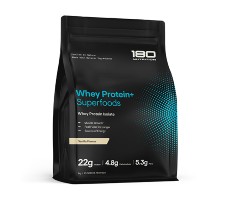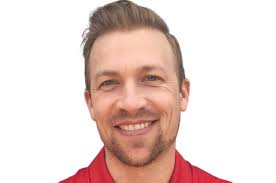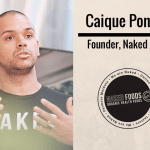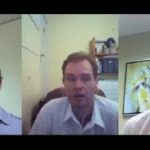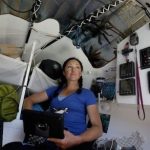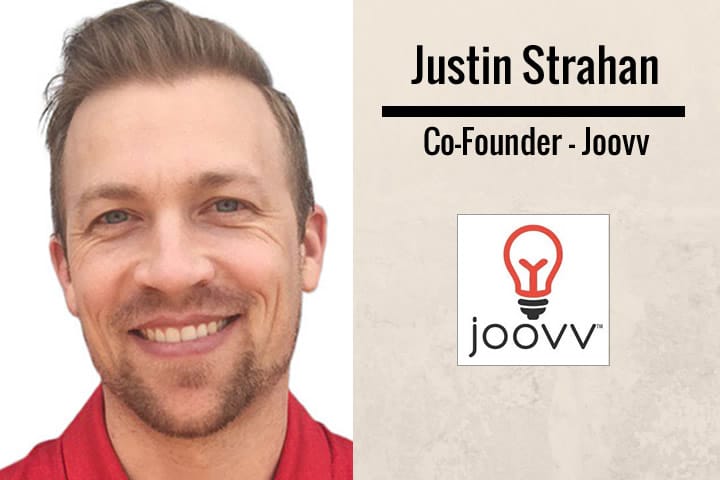
Watch the full interview below or listen to the full episode on your iPhone HERE.
Stu: This week we welcome Justin Strahan to the show. Justin is head of R&D at Joovv, an innovative company at the cutting edge of red light therapy devices. Red light has many scientifically proven benefits from muscle recovery, weight loss, skin health and joint pain and in this episode we dig deep into the science behind the technology… enjoy.
Audio Version

 Questions we ask in this episode:
Questions we ask in this episode:
- Exactly what is light therapy?
- How can we use it to better our health?
- How does colour play a part in light therapy?
Get More of Justin Strahan
If you enjoyed this, then we think you’ll enjoy this interview:
- Lyn McLean – What Everyone Should Know About Wireless Technologies
- Ariel Garten – Taking The Guesswork Out of Meditation
- Preventing Dementia, Alzheimer’s & Optimising Brain Function with Dr John Hart
Full Transcript
Stu
00:03 Hey. This is Stu from 180 Nutrition and welcome to another episode of the Health Sessions. It’s here that we connect with the world’s best experts in health, wellness, and human performance in an attempt to cut through the confusion around what it actually takes to achieve a long lasting health. Now, I’m sure that’s something that we all strive to have. I certainly do.
00:23 Before we get into the show today, you might not know that we make products too. That’s right. We’re into whole food nutrition and have a range of super foods and natural supplements to help support your day. If you are curious and wanna find out more, just jump over to our website. That is 180nutrition.com.au and take a look.
00:41 Okay. Back to the show. This week I’m excited to welcome Justin Strahan. Justin is the cofounder of a company called Joovv that specializes in making light therapy devices that can be used to enhance many different areas of our health. In this episode we talk about what light does to our body and how the wrong type of light can negatively affect our health. We’ll discuss the science behind light therapy and the clinical studies that support it as well. Very interesting stuff indeed. Okay. Let’s get over to Justin.
01:14 Hey guys. This is Stu from 180 Nutrition, and I am delighted to welcome Justin Strahan to the show. Justin, how are you?
Justin
01:21 Excellent. Thanks for having me.
Stu
01:23 Oh. No problems. Thank you for coming on. First up, Justin, for all of our listeners that may not be familiar with you and what you do in your work, I would love it if you could just give us a little bit of an indication of who you are, what you do, and perhaps why you do it as well.
Justin
01:38 Excellent. Yes. My wife and I, and her sister and husband are all cofounders of Joovv. We started the light therapy company about three years ago now, and it’s been an incredible journey. I have been the engineering side of the equation, if you will, responsible for designing and basically kind of the science behind our devices and some of the ways that they’ve been able to impact people.
Stu
02:08 Fantastic. Well, first up, congratulations on starting a business with your wife. Oh, crikey. I think I’d struggle to do that where I am. Fantastic. So, light therapy. I would imagine there would be a whole heap of people that don’t know what that is. And, so, explain it to us. What is light therapy?
Justin: 02:28 Light therapy is basically using specific wavelengths and intensities of red and near infrared light to help restore healthy cellular function. Most people are familiar with it from the beauty aspect. They’ve maybe seen it in a spa or clinic where they use it for facials and trying to improve skin texture and collagen production. And, it does absolutely work for that. But, what we’re trying to bring more awareness to is many of the other overall health benefits when you’re using a device that you can treat your whole body with.
03:01 Got it. Got it. So, this isn’t, this is not an old fashioned UV suntanning lamp is it? Because i remember, in my college days, I used to work in a supermarket just to pay the course fees. And, I remember a guy came in once, and his mum had this old fashioned suntanning lamp. And, he’d been out to the pub and got drunk and thought it would be a great idea to switch this thing on. He fell asleep in front of it, and …
Justin
03:28 Uh-oh.
Stu
03:30 So, hence he wasn’t working with us for a while. It took him about three months, but this is very different to that old school tech, isn’t it?
Justin
03:38 Yes. Exactly. Basically because you’re not having ultraviolet wavelengths which as you allude to in that story, there are some dangers that you have to be aware of with using those types of devices. The wavelengths we use are strictly in the red and near infrared spectrums, so they don’t have the ultraviolet rays in them or really any harmful or negative effects to be concerned with.
Stu
04:04 Okay. So, how would we use it? What would we do?
Justin
04:09 Basically, you would, ideally it’s something you would do daily, and it kind of goes back to the fact that our bodies are really designed to be used under light. And, for the vast majority of us, we simply don’t get as, nearly as much natural light as we should. Even for those of us who are in sunny climates where we’re able to a lot of the times, either our jobs or our responsibilities kind of prevent us from being able to do that as much as we should for our health. Then combine that with the fact that light therapy, because of the intensity and specific wavelengths, we’re actually able to help do some things that sunlight isn’t able to do.
04:50 So, it basically is something that we recommend people to add to their daily routine. Something where they could do a quick 10 minute treatment when they get up in the morning. We have a lot of people who enjoy doing it in the evening as well. So, it’s a very similar wavelength that you would see in a sunrise or sunset where you tend to get some of the more of the amber and red colors at those times of the day.
Stu
05:16 Okay. And, is this different to the lighting that we’re seeing in the infrared saunas? Because I’m a big fan of infrared saunas, and I get in there. And, it just works. I come out and i just feel energized and invigorated. I noticed in the infrared saunas that there is a little gadget there that allows you to change the color of the lighting so you can through red, orange, yellow, green, and all these different colors. I haven’t got a clue why. Didn’t know whether it was a bit of a disco thing. Is you tech similar to that? Or, are they different?
Justin
05:49 It’s actually quite different. So, a sauna is, the purpose of a sauna is to basically heat the tissues of your body. So, you’re able to induce heat shock proteins and you have this cardiovascular effect that is very similar to exercise. So, you can have the sweating and detoxing, and it has become popular for saunas to add these kind of small low powered LEDs of different wavelengths. They may have some mood or cognitive, I guess functions, but it’s totally separate than what we provide in our devices.
06:25 So, photobiomodulation, you’re using specific wavelengths. I mentioned the red and near infrared. The red typically between 600 and 670 nanometers, and then near infrared which of course is invisible to the naked eye between 800 nanometers and approximately 880 nanometers. So, those two specific ranges have been proven over literally hundreds and hundreds, in fact, thousands of studies now for a wide range of different health benefits.
06:58 Basically what they’re doing at their very core is they’re helping to restore the cellular function and the specifically in the mitochondria which basically acts as the engine of the cells. So, you get these really cool results such as increased ATP production, and basically impacts virtually every cellular function that … basically every cell of the body.
Stu
07:24 So, do people come typically then to you guy and say, look, I’m feeling lethargic. I struggle with waking up in the morning. What are the common complaints that you hear first off when people are intrigued in wanting to improve their health.
Justin
07:47 Yeah. It really is … it really runs the gamut. It goes from everything from people that are looking to improve the skin, their skin health, complexion, collagen production. We get professional athletes using it in mixed martial arts, NFL, we have some even rugby players, soccer players using it for their recovery process. Then we have folks as you mentioned that may be just dealing with a specific health issue or concern, whether it’s lack of energy or another common one would be thyroid function.
08:25 That’s one of our challenges quite honestly. From a marketing standpoint of trying to get awareness out there, we’ve become fairly well known in the kind of bio-hacking arena, in alternative wellness arena where more and more people are becoming familiar with the term photobiomodulation, or light therapy for various health benefits. What we’re really trying to do is bring awareness to the broad consumer that really, are really lacking in their overall health and light therapy and photobiomodulation can be a great way to help people improve their quality of life and really address a wide range of different health concerns.
Stu
09:14 Got it. Fantastic. Yeah. It’s tricky isn’t it? When you’ve got a product that does so many wonderful things, it’s difficult to know where to pitch it.
Justin
09:23 It is, and we initially started thinking that it would be really primarily for the skin health. That was one of the things that my wife had first seen the results for and was really impressed with. But, one of the things that kind of started to get us our name out there was actually for men and being able to increase their testosterone.
09:47 So, that was something that we didn’t anticipate becoming a thing, but it’s gone from that to, as I mentioned professional athletes to really a wide range of things. I can honestly say it works much better than I ever dreamed it would in terms of how effective and how much of a difference it can make in people’s lives.
Stu
10:06 Excellent. So, tell me what you do. So, for everybody that doesn’t know. The company is called Joovv, right? Where did the name come from? Is that like rejuvenation? Is that …
Justin
10:17 Yeah. You pretty much hit it. Then I can’t take credit for it, but we were trying to catch, come up with a name that would stick in your mind, and kind of a short easy website and things like that. But, yeah, it’s basically a play on the word rejuvenate.
Stu
10:33 Great. Okay. So, you make the devices that offer light therapy with all these wonderful colored lights doing some great stuff that’s clinically proven to work on the body. What do you do every day in terms of your use with these devices? How do you benefit from it?
Justin
10:54 I basically do a 10 minute session, and I have two of our kind of full body size units. So, I can basically treat the front of my body and the back of my body all in one 10 minute session. so, I typically would do it just kind of right before I showered. We’re still fairly worm here in California this time of year. So, it’s, especially with two panels like that, it can get a little bit of warmth, but not so much that you’re sweating profusely or something like that. But, it’s a pretty simple thing to add to your morning routine.
Stu
11:29 Yeah. Okay. No it’s interesting. And, safety. Obviously, you what it’s like when you first stumble upon something and it has great effects. You know, oftentimes you think, well I’m just gonna do this more. I’m just gonna sit in front of this thing every single day, eight hours a day. Can you over do it?
Justin: 11:54 I think, yeah. I think it’s something that with just a little common sense, it’s something that’s pretty easy to kind of I guess, self regulate and basically see how your body responds. What we’d recommend is a daily treatment of about 10 minutes per treatment area. So, we offer different sized devices, kind of to fit people’s individual goals, desired treatment areas and so forth. That’s the great thing about light therapy is you’re basically taking wavelengths that are in natural sunlight.
Justin
12:28 It’s very intense, but because there’s no UV, there really are no harmful affects to be concerned with. So, eye health safety is one thing that we get, I would say is a common question. We are registered with the FDA, and we’ve passed through testing that’s required for eye health safety. So, yes, we’ve gone through the necessary channels to where you can … when you purchase one of our devices you can know that it’s gone through very strict testing procedures from everything from electrical health safe-
13:00 That has gone through very strict testing procedures from everything from electrical health safety to eye health safety and so forth.
Stu
13:07 Fantastic. Can anybody and everybody use this in terms of children as well? I’ll get to why I ask that question in a second, but what are your thoughts on children?
Justin
13:21 Yeah. Well, I can tell you our children use it quite a bit. We have 6 children actually, oldest of which is 19, and kind of every age in between down to 5.
Stu
13:34 Right.
Justin
13:34 They’ve become quite accustomed to it. Even from the wound healing side of it. Our 6-year-old the other day fell on a scooter and got a little strawberry on his knee and of course, right away, he’s like, “Oh, I need to go do red light and get it treated.” They’re quite accustomed to it now.
Stu
13:53 Fantastic. The reason I ask is because we’re right in the middle of this smartphone era, I guess, generation, where we’re plugged into these things 24/7, whether we like it or not, through our jobs, through the way that we communicate with our friends and social media and all that stuff. That’s doing, I guess, a very different thing to our bodies and mitochondria and all that stuff at the other end of the spectrum with the blue light.
Justin
14:25 Yup.
Stu
14:26 What are your thoughts because I look at it as … What you’re talking about seems very restorative and life-giving and energizing but because we’re so engrossed in blue light, perhaps at wrong times of the day as well, I can see that, that might be quite disruptive on the other end of the spectrum. What are your thoughts on blue light?
Justin
14:48 Yeah. No, it’s been well demonstrated. I think people are starting to become more aware of the fact that artificial blue light, especially after hours, where our eyes really should be getting used to either darker wavelengths or basically, no light at all, as we get past sunset, it really has a detrimental effect to our circadian rhythm, to our hormone function, quality of sleep.
15:20 In fact, that’s one thing that a lot of people have noticed if they do a red light therapy session in the evenings is it really can help restore that, calm their body down because they tend to just be wired all the time. As you mentioned, most of us go from our laptops to our cellphones to a TV and then our cellphone some more before we go to bed. It’s definitely something that … Blue light is honestly even just a part of that function. You have the electromagnetic fields that we’re subjecting ourselves to with those devices as well.
15:57 The combined effect is it definitely has a detrimental effect on the cellular functions and photobiomodulation is a great way to help restore and rebuild that function, so we can basically be as healthy as we possibly can. As you mentioned, it’s something that’s difficult to get away from entirely, but it’s something that we do take fairly drastic steps to do what we can on that spectrum as well.
Stu
16:27 Would it be something that you might prescribe a session before bed to help sleep?
Justin
16:34 I would definitely try that if it’s something where your quality of sleep is suffering. I would definitely recommend trying and doing a session. I certainly have that. It has that effect on me and there’s some studies that have been conducted for this as well. There’s a study that was done on a volleyball team that they showed that it could improve the quality of sleep using red and infrared wavelengths.
Stu
17:03 Okay. In terms of the tech and … I guess, I’m intrigued first up, where did the idea come from?
Justin
17:15 Well, interestingly, it’s been actually around for several decades. It was originally called Low Level Laser Therapy or LLLT, sometimes referred to as cold lasers but they essentially use these specific wavelengths and they would treat small areas of tissue. Typically, it was used on joints, repairing after damaged cartilage or sprains or surgeries and so forth, something that’s typically used by physical therapists while there’s other medical practitioners that were using this as well.
17:50 Then, in the 90s, there were some studies that indicated that LEDs could actually be just as effective as lasers, only without some of the harmful effects, or at least, potential effects of overheating tissue that you can get with a laser. That really opened the door for what we provide today in a panel that can essentially treat your whole body with an effective dose of these wavelengths.
18:20 The critical factors, I mentioned the wavelengths are obviously important, the other, the thing that separates our devices from something like the LEDs that you see in an infrared sauna is the intensity. When you talk about the dosage of energy that you’re getting from these wavelengths is critical. Studies indicating benefits starting in the 5 to 6 joules per square centimeter range all the way up to 60, 80, 90 joules per square centimeter range for deeper tissue effects, whether it’s joint pain of improved recovery from workouts, muscle soreness, those sorts of things.
Stu
19:07 Yeah. It’s interesting. Would it be beneficial for me to go out to my nearest hardware store and just get a whole heap of red lights, right? I just plug it into my desk lamp and just stare at that thing for a half an hour. I’m not going to get the same results, am I?
Justin
19:24 You’re not going to. I mean, when I first started looking into this, I mean, that’s the natural inclination, right?
Stu
19:29 Yeah.
Justin
19:30 How do I make something that’s simple, easy to afford and I can make something myself? We actually experimented with infrared heat lamps. There are actually companies now offering this, whether it’s for a sauna or sometimes, even kind of referring to it as therapy. But what we found is because the wide range of wavelengths and also the heat that’s delivered by those are just simply not effective at providing the types of benefits that you see in the clinical studies of photobiomodulation.
Stu
20:06 Okay. How do you test these results in terms of getting a tangible tick to say, “Right, okay. That definitely works. We can see it works?”
Justin
20:16 Yeah. Well, I mean, some of the things that … We’ve gone through third party testing for example, for the actual light power output. For our, I guess, most popular device, it’s a modular unit, roughly three feet long by nine inches wide, delivers about 68,000 megawatts of light output. That’s something that we’ve had testing done. You can see we’ve had this spectrometer testing where you can see the range of wavelengths and so forth. We know that we’re matching the clinical data that’s out there for these studies. We’ve also been fortunate to have Dr. Michael Hamblin that serves on our advisory board, who’s widely regarded as one of, if not the leading expert of photobiomodulation, who’s a lead researcher at Harvard.
21:10 We’ve been able to match the design of our devices to the clinical studies, so that we know that it works. In terms of individuals kind of using the therapy and themselves, I would say most people within a couple of weeks are able to tell that it’s working, that they’re seeing some sort of benefits. It’s interesting because the things that people notice varies widely from individuals.
Stu
21:40 Yeah.
Justin
21:40 Where some people won’t notice they’ve slept like they can’t remember how long it’s been since they’ve had that good of a night’s sleep to people that we’ve had folks that are in their 70s, that are in nursing homes and they find out they basically can have energy like they haven’t had in many years.
22:03 It really depends on the individual but I would say most people are able to tell something. Some things certainly have a cumulative effect. For example, the kind health, collagen production, reduced wrinkles that have been well-documented, those types of benefits typically take several weeks to even months to start to really see benefits. I think part of that is just because we see ourselves in the mirror every day, so we tend to get used to that. But I know, for me personally, my parents lived out a state and I saw them after a couple of months of doing the treatment regularly and they can hardly stop talking about it to see the difference. Whereas, I wasn’t really even that conscious or aware of it.
22:49 Yeah, really depends on the individual but I would say, for people, especially that are in tune with their body, so athletes, I think it’s just across the board that people can really see the benefits.
Stu
23:01 Yeah.
Justin
23:02 It was interesting that when we first launched from the very beginning, we’ve actually had a 60-day return policy, so people could do the purchase the device and try it for a full 2 months. If they’re not satisfied, return it for a full refund and quite honestly, it was a little bit scary to do it off the bat. You wonder how many people are really going to see the benefits, are they investing the time to do it faithfully and those sorts of things, but to this day, we have a return rate of under 2%, which is mind boggling for a device like this. It’s been fun to see people see the benefits.
Stu
23:40 Fantastic. You offer quite a varying range in terms of size, cost as well. Where do people typically start? Would they delve in and go, “All right, just give me the whole full body system? I’m going heads up?” Or is it just the small one just to try?
Justin
23:59 I would say it’s kind of mix. Our previous generation, we had three different sizes and we often had people that wanted to upgrade. That was one of the driving factors behind changing to a modular system. Now, you could start with 1 device upgrade to 2, change it to 4 or eventually go all the way to 6, which is really more of almost like a professional type setup for full body coverage, 6 feet tall, about 30 inches wide. Yeah, it’s a mix. I’d say maybe, where half the people maybe start with one device, and then, the other half are starting with two, four, even six right away.
Stu
24:43 Okay. In terms of your demographic, who typically is your customer based upon your sales and data that you get from the …
Justin
24:55 It’s tough. It varies so much. We have, I would say, probably the bulk is in the 35 to 50 range both male and female, whether it’s for optimizing health, beauty or even athletic performance. But then, we also see, we have a lot of customers that are much younger than that as well. But yeah, I’d say that’s probably the strongest band is kind of that mid age between 35 and 50. I now fall within that range myself turning 40 earlier this year.
Stu
25:34 Yeah.
Justin
25:35 Yeah. It’s something I think more and more people are realizing that you can do a lot of things in life but if you don’t have your health, then, it’s not going to matter for much.
Stu
25:46 Absolutely right.
Justin
25:47 It’s been fun to see people really take their health seriously and then, hear the feedback as people can really see the difference and impact that light therapy has made.
Stu
25:57 Definitely, yeah. I’m intrigued because it’s … I like the fact that it’s a system that works externally-
26:01 I like the fact that it’s a system that works externally, but it also changes your biology, which means that it’s going to have an internal impact as well, and certainly if it gives you better sleep, first up, then you’re going to have all these wonderful repair systems that are occurring overnight and in turn could almost affect your gut health because you’re getting better sleep, you’re less stressed, all of the above, and when your gut health is optimal, then it’s a game-changer. Everything changes. Yeah, very interesting.
26:32 From a retail perspective, do you have … I live on the east coast of Australia here, and it’s quite a little hippie collective of float tanks and infrared saunas and all of these different modalities. Nothing in terms of light therapy, just outside of the infrared sauna stuff. Do you have light therapy studios over where you are? Is that starting to take off, or is that something that you’re getting into?
Justin
27:02 We are, to some extent. I would say it’s still very early on. I’m not sure if you guys have … If cryotherapy has become very popular over there, but cryotherapy has really become popular in the US and we actually have several facilities, soon to be dozens, that are implementing this new technology into their facilities. It’s something where it’s becoming more accessible.
27:32 Our primary business model has honestly been more direct to consumer, but we actually do quite a bit … We have quite a few customers in Australia. I can say it’s probably right after … It’s just about even with Canada in terms of second to the US. See, I can tell that the Australians are very interested in finding ways to improve their quality of life and health.
Stu
28:06 Anything, I guess, that you can do that lends you more energy and enables you to grasp life with more vigor is, yeah, it’s always going to be a plus. Yeah, we’re certainly very much an outdoor community, and being able to get out there and do that a little bit more is fantastic.
Justin
28:24 Definitely.
Stu
28:26 The future of light therapy. What have you learnt along the journey, and what do you see the future holding? How is that going to change?
Justin
28:39 I think the future of light therapy, it’s going to be something in the relatively near future where I think most people that really care much about their health, it’s going to be something where they have a device in their home that they’re able to help restore cellular function and to overcome some of the detrimental things that we’re surrounded by. Some that we can try to avoid to some extent, but some of them, as you mentioned, it’s just about impossible, whether it’s EMFs or blue light or toxins, all these things are disruptive to our biological function, so I think it’s going to become more and more critical that as a society we are doing things to invest in our health.
29:26 One time, real early on, talking with Dr. Michael Hamblin, he says, “I don’t know whether it’s going to be five years or 10 years, but,” he said, “one time, I envision every household having a light therapy device.” He said, “I don’t see any reason why it couldn’t be you guys.” I said, “I like the way you think.”
Stu
29:46 Yeah, totally.
Justin
29:48 That’s certainly one of the things that we’ve really tried to do, is just bring awareness and education to the industry. We have a learn page, a section on our web site where we go through the science in as great a detail as you could and as anybody would be interested in, and it goes also into various different health benefits and the science behind those, and every single article cites multiple published clinical studies, so if people can … They don’t have to take our word for it, they can dig as deep as they want.
30:25 Yeah, it’s something that’s been challenging, because most people aren’t very familiar with light therapy. Five years ago, I would have been in that boat as well, and I think naturally we tend, when you hear about it, it sounds gimmicky. It sounds like it’s too good to be true, but when you think about it, when you think about how our society has changed over the past 100 to 200 years, we’ve gone from people that were outside virtually all the time to now the latest numbers I’ve seen is Americans spend roughly 93% of their lifetime indoors and even in the past 10 to 20 years things have changed dramatically, as you mentioned, with computers and cell phones and wifi and Bluetooth. There’s a lot of things that we’re subjecting our bodies to that, quite frankly, our ancestors didn’t have to deal with even 40 or 50 years ago.
Stu
31:22 No, you’re absolutely right. Given what you know now, with all of the information and research that you’ve collected and discovered through your journey with Joovv and light therapy, what do you do from your household? You got kids, young guy, you’re married as well. How have you changed your perhaps structure of your day, in terms of how light, and maybe other things, you mentioned EMF as well, how that impacts your family?
Justin
31:57 Basically, we make it a priority to limit things that are known stressors on the body. For example, you won’t see lights on in our house after sundown. We basically would have … We literally have a Joovv light with red light that we’ll use in the background for lighting, and obviously we’ll end up watching TV or a movie or something like that, we would all of us, down to our six-year-old and five-year-old, we’ll actually have blue-light blockers that we’ll wear so that we’re not messing up our circadian rhythms.
32:34 Another thing that we’ve made a strong practice of is getting outside, so having our bodies connected to the earth for grounding, it’s not something we I guess got into a lot today, but being connected to the earth for the grounding and negative electrons that we’re able to get through that, and obviously getting as much natural sunlight as we can as well. Basically, doing a lot of things to limit the stressors on our body, so from EMFs we actually have gone away from wifi almost entirely. We have a router and we’ll kick it on if we need to for things, but I’m speaking to you now on a hard line connection so I’m not having to have wifi signal bouncing around my brain the entire time.
33:25 We do a lot of things like that. I actually will turn the power off to our house, just flip the breakers off, at night, because you can totally give your body a break from the electrical fields that you’re surrounded by all the rest of the time. A lot of things like that that we can do to limit the stresses on our body, and then do things helpful like getting natural light, getting the photobiomodulation, things to help restore that cellular function and the quality of life really boils down to health, so there’s a lot of things that you could have going for you in life, but if you don’t have your health it’s not going to matter much.
Stu
34:08 No, absolutely right. It’s funny, because you mention EMF and EMR and all of these different things, and it literally is the one-percenters that just impact to either poor health or contribute to better health. I’ve had a few guys on the show who specialize in electromagnetic fields and electromagnetic radiation, and yes, it is something which I think that we’re probably not going to understand the full effects of for the next maybe 10 years, when we have become this wifi population, specifically with the youngsters as well, when they’re learning with tablets and everything that comes with that and being in that zone, so yeah, anything I think that you can do just to dial back that exposure is going to be a good thing.
Justin
35:00 Definitely.
Stu
35:02 We’re just coming up on time, but I wanted to ask you about the non-negotiables that you personally do to ensure that you crush each and every single day. You may have touched on some of them already, but things like maybe you get up first thing and it has to be at a certain time, and you have a big glass of water, or something like that. What does a light therapy expert do every day, without fail?
Justin: 35:28 I don’t know if I can say every day without fail, but I definitely make it a priority and most days I will be getting up early and either going surfing or going for a walk on the beach with my wife. One of those two things, both of which you’re able to be connected to the earth and seeing the sunrise.
Justin: 35:50 Then also sometime throughout the day, in the afternoon basically, giving my mind a break, getting outside, feet in the grass, and as much body exposed to sunlight as possible, so that is a for sure. I literally have reminders to make myself do that. Then thirdly is essentially no blue light after sunset. Those would be my top three.
36:20 Fantastic. Bingo. That’s good advice, and I think if followed … It’s amazing, isn’t it? When you get up … I guess the circadian rhythm fits into that as well. If you’re getting up early and you’re exposing yourself to natural light, then you’re setting the right path for your circadian rhythm, and if you’re not exposing yourself to blue light in the evening, which is effectively like jet lag, then you’re on the right track as well, so brilliant. Fantastic.
Stu
36:48 Look, it’s been really, really interesting to chat to you, and I am super intrigued. For our audience, if they want to find out more, where would be the best place for me to send them?
Justin
36:59 Yeah, you can head over to www.joovv.com, and we have an excellent web site that I can’t take any credit for other than helping to write quite a few of the articles, but there’s a learn page I referenced earlier that you can dig into the science. We also have reviews. That’s honestly my favorite part of what we do now, is getting to see multiple five-star reviews every day that come in where we can hear the impact that it’s having on people’s lives. Whether you’re wanting to dig into the science or read firsthand what other customers are experiencing, those are two great ways to get started.
Stu
37:44 Fantastic. We’ll put that in the show notes, and share it across social media. I’m super excited to tell everybody what you guys are doing, because it sounds fantastic.
Justin
37:55 Thanks.
Stu
37:55 Thank you so much for your time, and hopefully I will speak to you in the near future.
Justin
38:01 Excellent. Sounds good. Thanks a lot, Stuart.
Stu
38:02 All right, you take care. Thanks.

